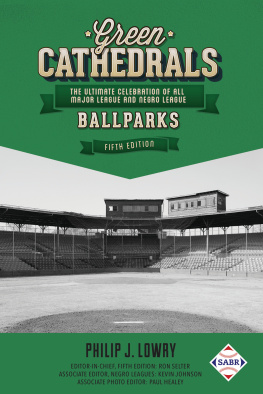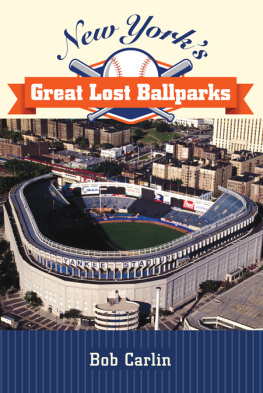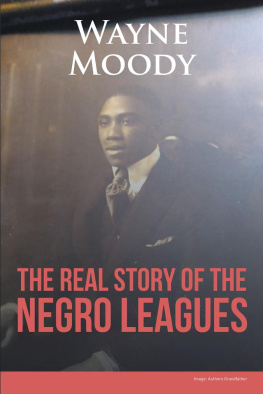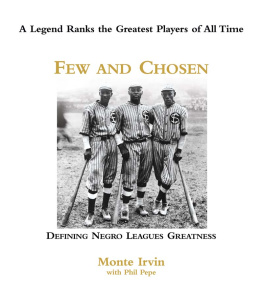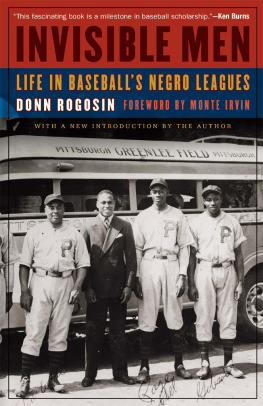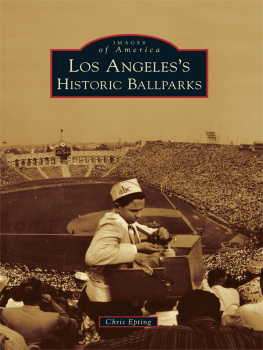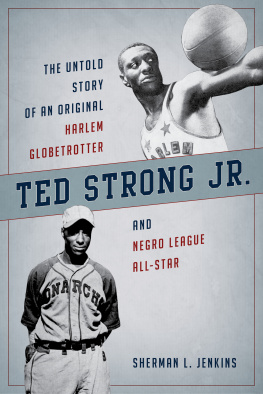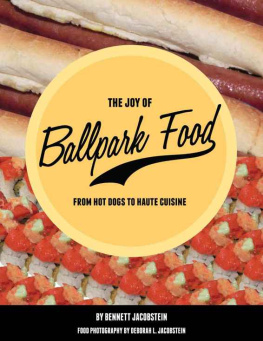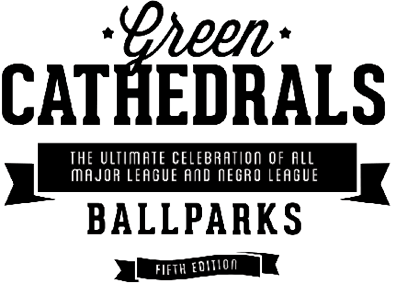Philip J. Lowry Editor-In-Chief, Fifth Edition: Ron Selter Associate Editor, Negro Leagues: Kevin Johnson Associate Photo Editor: Paul Healey Society for American Baseball Research, Inc.Phoenix, AZ
Green Cathedrals The Ultimate Celebration of All Major League and Negro League Ballparks FIF TH EDITION Copyright 2019 Society for American Baseball Rese arch, Inc. All rights reserved. Reproduction in whole or in part without permission is p rohibited. Paperback ISBN 978-1-9 43816-57-6 Ebook ISBN 978-1-9 43816-56-9 Cover and book design: Gilly Rosenthol Thanks to Bernard McKenna of University of Delaware for information on Negro League ballparks in Baltimore. Society for American Basebal l Research Cronkite Sch ool at ASU 555 N.
Central Ave. #416 Phoenix , AZ 85004 Phone: (602 ) 496-1460 Web: ww w.sabr.org Facebook: Society for American Basebal l Research Twit ter: @SABR
FOREWORD
By Bob Bluthardt If Phil Lowry had been Captain Ahab and if a ballpark replaced Moby Dick, then the story would have ended several chapters earlier and, I would suspect, more successfully. This fractured literary analogy is my way of noting with great admiration that no man has spent more time seeking more data about more ballparks than Phil Lowry. An obsession? Perhaps, but in the Society for American Baseball Research (SABR) there are no obsessions, though many members do spend hours seeking the ultimate truth! Welcome to Green Cathedrals , a book of all things ballparks, including facts and factoids, dimensions and capacities, locations, occupants, names and nicknames, architects, and phenomena, where Phil compiles hundreds of stories that will probably make their way into some radio broadcasters rain delay performance. Beware, there is a little of the whimsical Phil here too as he stretches the occasional fact into an unusual observation. I first met Phil in 1982 at the societys annual meeting in Towson, Maryland, just outside of Baltimore.
SABR affairs in those days were smaller and somewhat chummier, thus a less frantic schedule allowed you to see and do everything, and we all were energized by Phils ballparks history revival speech. At that point, Phil had been working for years on what would become the first edition of Green Cathedrals , published by SABR in 1986. Phils enthusiasm led to the creation of the Ballparks Research Committee of SABR. Of course, Phil didnt invent either ballparks or their history, but timing is indeed everything and few writers had given the games cathedrals their due before Phil. In 1975, Bill Shannon and George Kalinskys The Ballparks marked the first of a soon growing line of ballparks histories, but Phils first version of Green Cathedrals provided a unique collection of data about all Major League and Negro League parks since the professional age began in 1871. Ballparks as a building invention date to the 1860s, when entrepreneurs created a facility to keep the paying faithful inside and everyone else outside.
As the club teams of the 1850s became the semi-pro teams of the 1860s and the full-fledged mercenaries of the 1870s, the business of baseball transformed the crude wooden stands of the late nineteenth century to the brick, concrete, and steel edifices of the twentieth century. When we speak of the classic parks, we mourn the passing of Forbes, Ebbets, Crosley, Shibe, Griffith, Sportsmans, and lately, Tiger, Comiskey, and the original Yankee Stadium. Phil does not limit himself to the twentieth century, nor is he a snob who deals with just the American and National leagues. As a ballparks progressive he includes all Negro leagues, the Players and Federal leagues, and many more. He also seeks the neutral sites used when fire, flood, local ordinance, or other obstacles prevented a game from taking place at a regular site. Read the entire text as you may find a major league game that took place in your backyard.
So, why should you care about all this? Even as a baseball fan, you might consider this material a little arcane and esoteric. You shouldnt! Baseball has two charming aspects that separate it in both style and intensity from other sports: statistics and stories, and Green Cathedrals will wash over you with both. And we all know that often-repeated quote that says if we are to understand America, we must first understand baseball. Well, I would suggest we must understand ballparks to understand baseball. If baseball is a game of inches, isnt it worthwhile to know how those inches have shaped the game at so many ballparks? A higher wall, a shorter power alley, a screen or not over the bleachers: How many such factors can (and did) change the game and its numbers? Most sports take place in standardized settings, but once you follow the ninety-foot square infield and place the pitchers mound sixty feet and six inches from home plate, the rest is left to chance or some interesting and purposeful design aspects that continue in this modern era of retro-classics. Growing up at Fenway Park I assumed that all ballparks were quirky and angular places where batted balls bounced off of walls, ladders, and poles.
Imagine my surprise when I first visited Veterans Stadium in Philadelphia! Regardless of your ballpark past, enjoy this book. It will fill many a rain delay, win you a few trivia contests, and fill you with an appreciation and new perspective of the national pastime and its developing homes for the past 140 years. Read this book and you will never look at a ballpark in the same manner. And if you see a mistake or can suggest an addition, feel free to contact Phil as Captain Ahab sails again soon. Robert F. Bluthardt, June 2013 Ballparks Committee, Society for American Baseball Research
PREFACE
By Phili p J.
Lowry Here are the vital statistics for our 30 current Major League parks, and more importantly, for every one of baseballs storied shrines of the past where regular season or post-season championship Major League or Negro League baseball games have ever been played. The saga of Major League ballparks dates back to 1871, and includes an incredible variety of playing sites, from cricket grounds, polo fields, and beer taverns to race tracks, fair grounds, and cow pastures. There were even two palaces in two of Americas best baseball towns, Cincinnati and St. Louis. When the fourth edition of Green Cathedrals was published back in 2006, 404 ballparks were cited which were the home parks of all Major League/Negro League teams. After much further research, you will find here data and descriptions for 583 ballparks.
There have been several ballpark books since mine, but no one else has ever provided a complete listing of every Major League/Negro League ballpark. All parks, that were the home parks of Major League/Negro League teams used or intended to be used for regular season league games or officially sanctioned post season games, are included. Ballparks used by Major League/Negro League only for exhibition and/or spring training games are excluded. The focus is on ballpark geometry, the oddities in play caused by unique and crazy configurations, and what makes the game fun for fans. All dimensional changes are catalogued and dated in outfield fence distances and heights. This is crucial to understanding the statistical history of baseball.
The following leagues are covered: NANational Association, 1871-75 NLNational League, 1876 to date AAAmerican Association, 1882-91 UAUnion Association, 1884 NCLNational Colored League, 1887 PLPlayers League, 1890 ALAmerican League, 1901 to date FLFederal League, 1914-15 NNLNegro National League, 1920-31, 1933-48 ECLEastern Colored League, 1923-28 ANLAmerican Negro League, 1929 NSLNegro Southern League, 1932 NEWLNegro East-West League, 1932 NALNegro American League, 1937-61 I differ from most baseball authors by including the Negro Leagues as major leagues, rather than as somehow a different category. I was very fortunate to attend a three-day 1982 conference in Ashland, Kentucky, attended by almost all of the living Negro League veterans, and I interviewed each attendee on the amazing variety of ballparks used for regular season games by barnstorming Negro League teams. Concerning inclusion of the Negro Southern and Negro East-West Leagues in 1932, none of the three other principal Negro Leagues (NNL, ECL, NAL) were operating in 1932. Since the NSL and NEWL were the only Negro Leagues that year, they should be considered the same as all of the other Negro Leagues. Although the historical record is still incomplete for the Negro Leagues, an unbelievable amount of time and effort has been invested by many people to assemble what historical records do exist on the Negro Leagues. The most notable has been done by members of the Negro Leagues Committee of SABR and the Negro League Baseball Museum in Kansas City.

